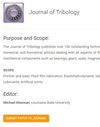On the Lubrication and Stability Behaviors of a Conical Hybrid Floating Ring Bearing with Thermal Effects
IF 3
3区 工程技术
Q2 ENGINEERING, MECHANICAL
引用次数: 2
Abstract
The conical bearing can withstand both journal and axial load because of the conical-shape fluid film, and an investigation concerning the thermodynamic lubrication and stability properties is proposed for a conical hydrostatic/hydrodynamic floating ring bearing theoretically and experimentally. The finite element method is coupled with the finite difference method to solve the variable-viscosity Reynolds equations, thermal energy equations, and the corresponding boundary conditions for the inner and outer films in a floating ring equilibrium state, and the conical bearing-rotor dynamic and stability performance models are built up with the perturbation theory and Routh-Hurwitz method. The primary characteristics parameters that are obtained under different operational conditions suggested that there presents a significant temperature gradient distribution over the lubricated domain, the thermal effects decrease the load carrying capacity, friction power loss, and stiffness and damping coefficients, and the viscous dissipation influences the variation of threshold instability speed with eccentricity and reduces its maximum value. In experiments, the temperature distributions of the oil leakage flow are measured to compare with the calculated results for the validation of the mathematic model using an infrared thermal imager, and the thermal effects need to be taken into consideration for the bearing lubrication analysis and design.考虑热效应的锥形混合式浮环轴承润滑与稳定性研究
由于锥形流体膜的存在,使得圆锥轴承能够同时承受轴向载荷和轴向载荷,因此从理论上和实验上对圆锥动静压浮环轴承的热力学润滑和稳定性进行了研究。将有限元法与有限差分法相结合,求解了浮环平衡状态下内、外膜的变黏度雷诺方程、热能方程及相应的边界条件,并利用微扰理论和劳斯-赫维茨方法建立了圆锥轴承-转子的动态和稳定性能模型。在不同工况下获得的主要特性参数表明,润滑区域存在明显的温度梯度分布,热效应降低了承载能力、摩擦功率损失以及刚度和阻尼系数,粘滞耗散影响了阈值失稳速度随偏心距的变化,降低了其最大值。在实验中,利用红外热像仪测量了泄漏油流的温度分布,与计算结果进行了对比,验证了数学模型的正确性,并在轴承润滑分析和设计中考虑了热效应。
本文章由计算机程序翻译,如有差异,请以英文原文为准。
求助全文
约1分钟内获得全文
求助全文
来源期刊
CiteScore
4.20
自引率
12.00%
发文量
117
审稿时长
4.1 months
期刊介绍:
The Journal of Tribology publishes over 100 outstanding technical articles of permanent interest to the tribology community annually and attracts articles by tribologists from around the world. The journal features a mix of experimental, numerical, and theoretical articles dealing with all aspects of the field. In addition to being of interest to engineers and other scientists doing research in the field, the Journal is also of great importance to engineers who design or use mechanical components such as bearings, gears, seals, magnetic recording heads and disks, or prosthetic joints, or who are involved with manufacturing processes.
Scope: Friction and wear; Fluid film lubrication; Elastohydrodynamic lubrication; Surface properties and characterization; Contact mechanics; Magnetic recordings; Tribological systems; Seals; Bearing design and technology; Gears; Metalworking; Lubricants; Artificial joints

 求助内容:
求助内容: 应助结果提醒方式:
应助结果提醒方式:


